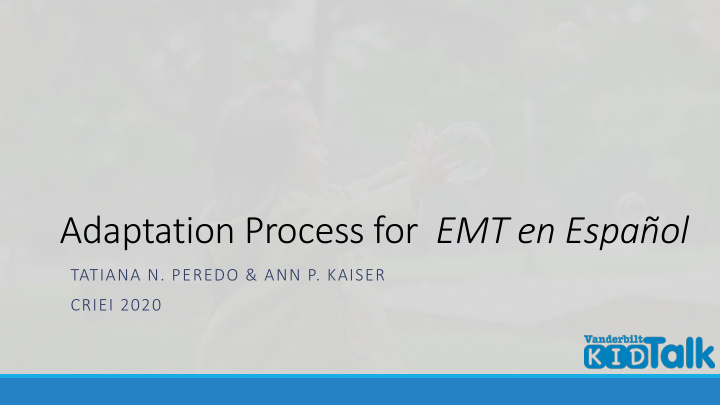



Adaptation Process for EMT en Español TATIANA N. PEREDO & ANN P. KAISER CRIEI 2020
What is EMT en Español ? An adaptation of Enhanced Milieu Teaching (EMT) • Evidence-based naturalistic language intervention for early language development • Caregiver implemented EMT is an effective way to support children’s language development Utilizes the Teach-Model-Coach-Review training approach Selected citations: Kaiser et al, l993; Scherer & Kaiser, 2010; Wright et al, 2013; Roberts & Kaiser, 2012; Kaiser & Roberts, 2012; Roberts & Kaiser, 2015
Current Evidence for EMT en Español EMT en Español is effective increasing caregiver use of strategies with their children with DLD • Single case study (Peredo, Zelaya, & Kaiser, 2017) • Small RCT study (Peredo, Mancilla-Martinez, & Kaiser, in preparation) Ongoing RCT(N=90) to examine immediate and longer-term effects of the intervention on children ’s language outcomes
Adaptation Process Adapt Test • Review Propose literature • Gather adaptations input Get feedback
Social Validity Measures Survey using video Feedback from caregivers Observational measures examples of who participated in of caregiver use of professionals who work intervention strategies with Spanish-speaking • Evaluation of intervention Latinx families from low- program income households. • Evaluate cultural acceptability of individual strategy
Initial Adaptations
Caregiver Coaching Approach No adaptations were made Teach-Model-Coach-Review approach was found to be culturally appropriate Teach Coach Model
Setting a Context for Communication Strategies Adaptations/ considerations • Environmental arrangement • Use play-based strategies in • follow the child’s lead familiar home routines • Respond • Notice and comment on the • Balance turns child’s interests within adult - • Mirror and map directed activities
Language Targets and Expansions Strategies Adaptations/ considerations • • Model target words Use short morphologically rich phrases • • Use short phrase Model first person singular, first person • Expand child communication by adding plural, third person singular, and present more information to child’s utterance or progressive inflection of verbs • correcting child’s grammar Use family dialect and specific vocabulary • Expand by adding a verb, noun, or descriptive words instead of pronouns
Communication Elicitation Procedure Strategies Adaptations/ considerations • • Set up requesting opportunity Teach a simplified procedure for specific • Use hierarchy of prompting based on least routine amount of support the child needs in that moment • Visual • Open question • Choice question • Model or “say” prompt
Observational Measures of Caregiver Use of Strategies
Parent use of matched turns and targets: single case Peredo, Zelaya, & Kaiser (2017). Teaching Low-Income Spanish-Speaking Caregivers to Implement EMT en Español With Their Young Children With Language Impairment: A Pilot Study. AJSLP
Parent use of expansions: single case Gato El gato duerme Peredo, Zelaya, & Kaiser (2017). Teaching Low-Income Spanish-Speaking Caregivers to Implement EMT en Español With Their Young Children With Language Impairment: A Pilot Study. AJSLP
Parent use of communication elicitation strategy: single case Peredo, Zelaya, & Kaiser (2017). Teaching Low-Income Spanish-Speaking Caregivers to Implement EMT en Español With Their Young Children With Language Impairment: A Pilot Study. AJSLP
Parent use of strategies: RCT Adult % Matched Turns 60% 50% 40% 30% 20% 10% 0% Pre Post Follow-Up Intervention Control
Caregiver Participant Feedback
Feedback Summary (N=5) • All caregivers rated “coach” as the most helpful component in their learning • 3 caregivers reported teaching strategies to someone else (siblings, husband, aunt) • All reported they thought the intervention helped their child • Caregivers rated all strategies on a 1-5 scale (1= least effective/culturally appropriate to 5= most effective/ culturally appropriate). Response averages ranged from 4-5. • Not giving instructions was rated lowest • How effective was not giving instructions to your child during activities ( M =4.14) • What would other Latino parents think about the effectiveness of not giving instructions ( M =4) • How did not giving instructions fit with your parenting views ( M =4.2)
Future Directions in Adaptations Refining of strategies to be more culturally congruent • Types of directions • Matched and related turns • Specific linguistic targets by activities
Other Considerations in Adapting Interventions for Populations Underrepresented in Research Thinking about how to engage participants at every stage 1. Recruitment • Building relationships with community partners • Being referred by a trusted person • Mode of communication (e.g., WhatsApp) • Establishing relationships quickly with families 2. Accessibility of participating in research • All testing and intervention sessions at home 3. Keeping participants engaged • Compensation • Flexibility
Recommend
More recommend